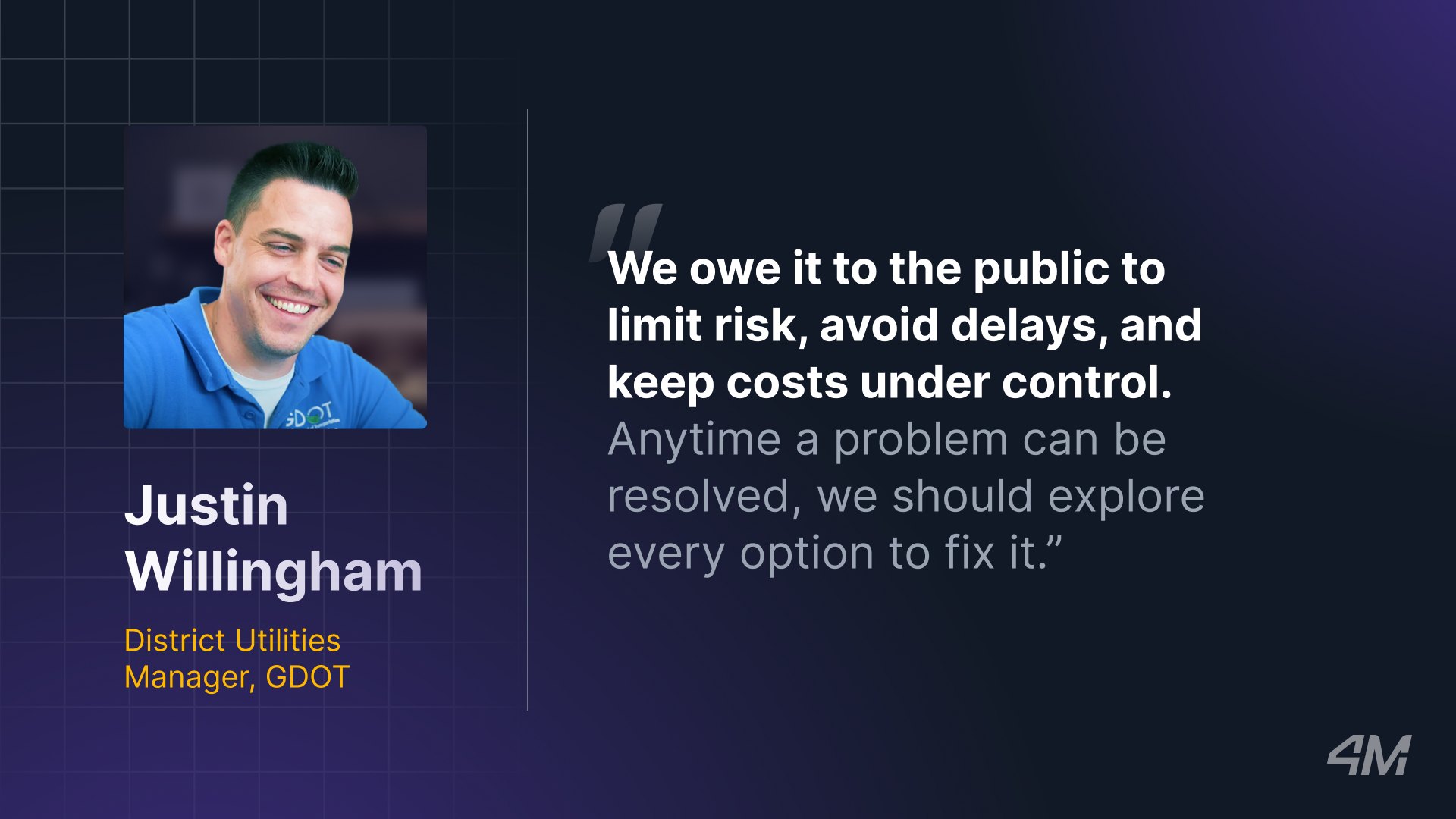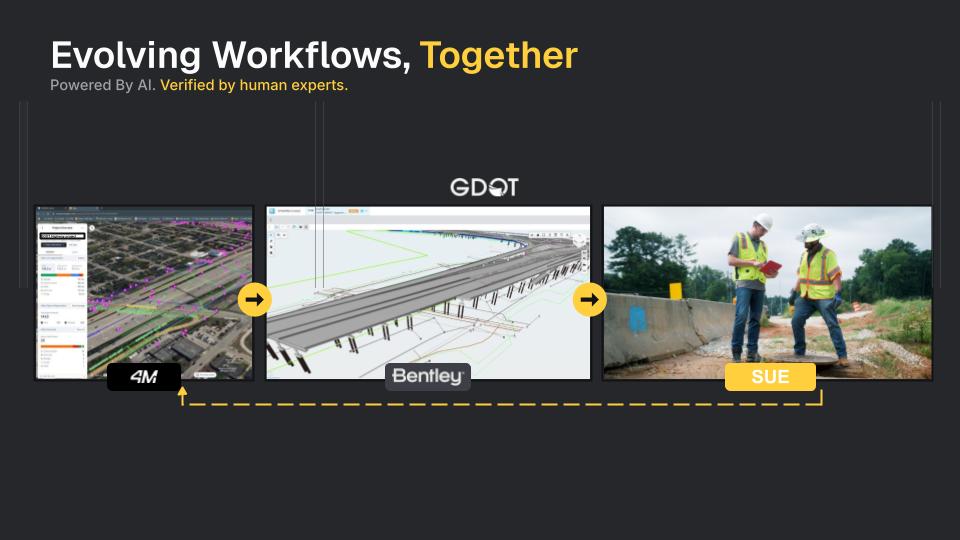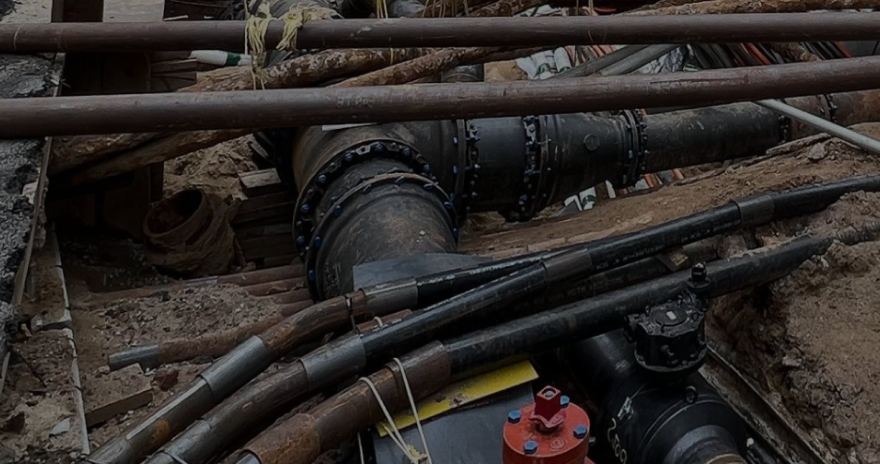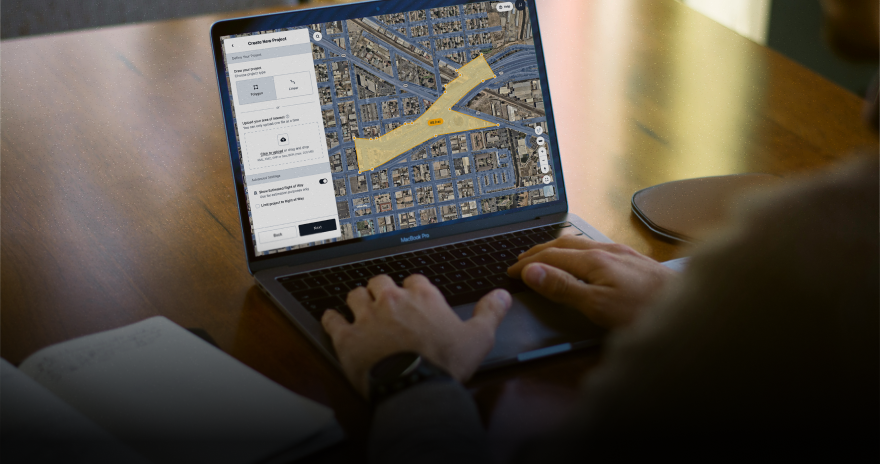GDOT Scales 4M Utility AI Statewide to Power Smarter Project Delivery
Written by

Published on
October 30, 2025
.png)

Table of contents
Background
The Georgia Department of Transportation (GDOT) manages one of the largest state transportation networks in the Southeast, with nearly 4,000 employees responsible for thousands of miles of roads, bridges, airports, and waterways across Georgia. As a leader in infrastructure innovation, GDOT is committed to finding smarter, more efficient ways to deliver projects that serve the public interest while managing tight budgets and complex utility coordination challenges.
On any given stretch of corridor in Atlanta, GDOT can encounter anywhere from 14 to 19 different utility owners in the right of way. With aging infrastructure, fragmented data, and incomplete records, knowing what's underground before breaking ground has been nearly impossible—until now. After a successful pilot, GDOT decided to partner with 4M to bring AI-powered utility intelligence into their workflows statewide, transforming how they plan, design, and build.
Key Results
- 1,800 Man-Hours Saved compared to traditional manual utility research processes. "The return on investment is ridiculous," says Nick Fields, State Utilities Administrator at GDOT. "We've done the numbers on time savings. It was a no-brainer for us."
- 100% Utility Capture Rate with 3-Foot Accuracy during GDOT’s pilot with 4M on State Route 166. 4M detected every subsurface and aboveground utility in the test corridor, with line depictions accurate to within three feet of existing SUE deliverables.
- Week to Hour Turnaround for concept planning preparation. What previously took GDOT teams a full week to prepare for concept meetings now takes approximately one hour using 4M's utility AI mapping platform.
- Statewide Deployment to 150+ Users. Following successful pilots, GDOT rolled out 4M across the state, with training planned for utility coordinators in all districts.
Straight from the Source
Before GDOT could confidently roll out 4M statewide, they wanted to test 4M during a pilot program. Hear from Justin Willingham, GDOT District Utilities Manager, and Aisha Moultrie, State Subsurface Utilities Engineer, as they discuss GDOT’s utility challenges and the impact 4M could make.
Challenge: Manual Processes, Incomplete Records, Costly Delays

For state DOTs, utility conflicts aren't just inconvenient—they're expensive, dangerous, and too often avoidable. Historically, GDOT faced the same challenges as DOTs nationwide: conventional records research methods required sifting through historical paper files, scattered digital records were unreliable, and getting timely responses from utility owners was difficult. Knowledge gaps continued to grow as experienced staff retired.
"The challenge is how can we identify utilities earlier," Willingham explains. "We have these old facilities that have to be maintained, and utilities are just still piling in—there's nowhere else to go. If we don't evolve, we would be in trouble."
Traditional processes relied on coordination with utility owners to understand what was underground, but even they didn't always have complete data. "You can try to figure out, 'Is there something we're not seeing?' That can take a lengthy amount of time," Willingham notes. "And sometimes they don't always know what's there."
These data gaps created real consequences and for GDOT, the stakes were clear.
"When there's a better way to do something, you have to explore it," Fields says. "When there's a more efficient way to do something, you have to consider it. So we've decided that as an agency, we can do better. And we're going to do better."
Solution: Instant Utility Data You Can Trust and Verify
GDOT took a rigorous approach to testing 4M's platform. They selected a one-mile stretch of State Route 166 on the southwest side of Atlanta—a location where they had recent SUE QL-A data to use as a benchmark. The goal: put AI-powered utility data to the test against known ground truth.
"At the end of the day, we have design decisions to make. During construction, we have potentially modifications to as-built that are real time, and we have to have a level of confidence in what we're doing," Fields explains. "And so we wanted to put the product to the test."
GDOT didn't share their existing SUE data with 4M upfront. Instead, 4M used its AI conflation process to capture and verify utility data independently. When GDOT compared the results, they were surprised by what they found.
4M captured 100% of subsurface and aerial utilities in the corridor, with line depictions accurate to within three feet of existing SUE deliverables.

"We were very surprised to see that the product captured every single subsurface and aerial utility in that stretch of right of way," Fields says. "It really caused us to start thinking: if we can use an AI approach to an effort that we do manually and get a greater level of accuracy—not to replace SUE, not to replace due diligence, not to replace human verification—but if it helps us along the way, then for us, that's a return on investment and something we should consider."
Beyond accuracy, GDOT discovered dramatic time savings. For a typical interchange reconstruction project in South Georgia, preparing for concept meetings traditionally took a week of manual data gathering. Using 4M, teams had information within minutes, and everything they needed to prepare for concept within an hour.
"Incorporating 4M technology into the design early in the concept phase is going to go a long way," Willingham says. "Having a map that will show you where an existing utility is, or there's an underground facility we didn't know was there—that's going to improve GDOT's ability to avoid conflicts."
Additionally, 4M's Utility AI Mapping platform allowed GDOT to:
- Make early decisions on public interest determination and advanced utility relocation strategies without waiting for 30%, 60%, or 90% design plans
- Give SUE consultants an AI-powered foundation that supplements SUE QL-D data, eliminating weeks of manual records requests
- Provide construction inspectors with real-time utility data when contractors encounter unexpected lines or abandoned facilities
- Access immediate utility information during emergency response situations like hurricanes or bridge fires
Concept Planning: Faster, Smarter Decision-Making
"We’re using AI as a tool to help us prepare conceptually—we can approach concept team meetings having discussions on critical utilities, approaches to the design that may or may not work, or considerations we need to think about beforehand," Fields notes. "A lot of those decisions can be made without having a set of 30%, 60%, or 90% plans. For us, that’s powerful."
This early visibility enables GDOT to make decisions on public interest determination, where they decide upfront that the project is significant enough and beneficial to the public to put all facilities in the contract. Since they pay for all utility relocations, they can now make decisions about advanced utility relocation by taking a look through AI conflation. These decisions, which previously required months of design work, can now be made at the concept stage.
SUE Supplementation: Building on a Verified Foundation
Rather than starting from scratch with records requests to dozens of utility owners, GDOT's SUE consultants now begin with 4M's AI conflation product as a baseline. "Our SUE consultants, instead of signing all these different letters to go to utility owners and property owners to ask for records—which, you know, there's still an element of that that's going to happen—they can begin with an AI conflation product that will supplement quality level D data," Fields explains.
This approach doesn't replace traditional SUE methods: it accelerates them by providing a verified starting point that consultants can build upon. “We love the fact that it's powered by AI and verified by humans,” Fields notes.
Construction Support: Real-Time Utility Intelligence in the Field
When construction is underway and surprises inevitably arise, GDOT inspectors now have instant access to utility data. "If we move to construction and we have inspectors who are out on the ground and a contractor comes across a line that was abandoned or something that wasn't picked up in our UTLE file, our inspectors are going to go to this product to see if there's more data that can help inform the decision," Fields says.
Emergency Response: Minutes Instead of Hours
During critical incidents—hurricanes, bridge fires, or other emergencies—every minute counts. "If we have a hurricane come through the state of Georgia and we've got down lines across interstates, or we've got a bridge that's on fire and we don't know who's attached to the bridge—instead of spending an hour trying to find SUE plans to get an idea or sift through permits, we're going to this AI tool to see what data we have real time. Right then. Right now."
More importantly, by integrating 4M's data across their workflows, GDOT can identify utility conflicts and make design adjustments early—before they become expensive change orders during construction.

"We can avoid these delays during construction by knowing what's exactly there and planning for it appropriately. Anytime a problem can be corrected, I think you have to explore those options," Willingham says. "We owe it to the public to try to find the most cost-effective and efficient way to do a process: to avoid costs, delays, and risk."
Aisha Moultrie, State Subsurface Utilities Engineer at GDOT, agrees with the value of 4M’s instant, reliable utility data. “Starting every project with 4M means starting with more complete records. Since records are the foundation of SUE, this sets the stage for better outcomes throughout the project lifecycle.”
Looking Forward

GDOT's adoption of 4M isn't just about current projects—it's about preparing for the future of digital infrastructure delivery. Following the successful pilots, GDOT has deployed 4M statewide, with training planned for 150+ utility coordinators across all districts.
The agency is now piloting the integration of 4M's data with 3D SUE deliverables in Bentley's OpenRoads Designer. The vision: use AI conflation as a baseline 3D model, then build upon it with traditional SUE efforts to create comprehensive design-ready utility information.
"We're moving into digital delivery, into the 3D environment," Fields says. "Utilities is certainly not an office that wants to be left out of that discussion. So we're going to continue to evolve, and we're grateful for partnerships with companies like 4M to help us do that."
The approach is pragmatic and forward-thinking. "It's not that a 3D model of AI data is going to be the end product. But why can't it be the beginning?" Fields asks. "We're going to use SUE data to build a 3D model for design decisions. But if we give them a hand up and incorporate it into the process, eventually the product evolves. And we build better together."
"4M doesn't replace our field verification," Fields emphasizes. "But it supercharges our ability to plan and prioritize intelligently, making our SUE efforts more strategic, not just reactive."
GDOT's collaboration with 4M represents a strategic shift toward proactive, data-driven infrastructure delivery. By improving efficiency, enhancing quality, and increasing safety across the project lifecycle, GDOT is setting the standard for state DOT innovation.
Recent blog posts

Our Newsletter
Join 7k infrastructure professionals
Get monthly insights on ways to build smarter, faster and safer with Utility AI.




.avif)
.png)
